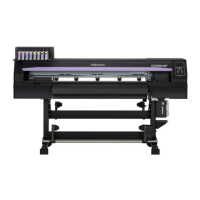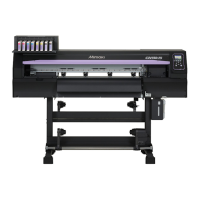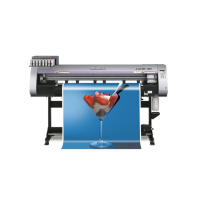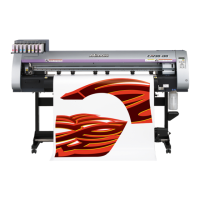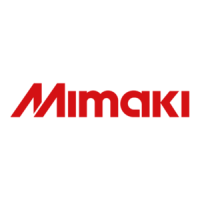Do you have a question about the MIMAKI CJV150-107 and is the answer not in the manual?
Outlines the limited warranty terms and conditions.
Covers user requests, FCC statement, and interference warnings.
Welcomes users and explains the manual's purpose and content.
Explains warning symbols and their meanings for safe operation.
Advises on keeping body parts away from moving components.
Instructions for safe handling of the power cable.
Precautions for handling ink and ink cartridges safely.
Safety advice regarding the cutter blade and handling.
Covers power supply, heater, maintenance notes, clump lever, and dust protection.
Warnings about moving parts and precautions with cutters.
Covers replacement parts, disposal, dust protection, and media handling.
Details unsuitable installation environments for the machine.
Secure a suitable installation space and consider environmental temperature.
Step-by-step guide for moving the machine on a step-free floor.
Identifies and describes the front-side components of the machine.
Explains the display, status lamp, and ink status icons.
Details the functions assigned to the FUNC1, FUNC2, and FUNC3 keys.
Describes essential components like media sensor, carriage, cutter, capping station, and rollers.
Connects the PC and the machine using a USB2.0 interface cable.
Instructions for connecting the power cable to the machine and outlet.
Indicates ink status via lamps and provides expiration date information.
Lists usable media sizes and specifications for different models.
Provides precautions for handling printing media.
Explains the different operation modes: Not-Ready, Local, Menu, and Remote.
Adjust the head height according to the thickness of the media you use.
Move the pinch roller unit to adjust the position of the pinch roller.
Set the media so that the right end of the media will be inside the area shown below.
Set the operation method for the take-up unit and tension bar.
Adjust the take-up torque with the torque limiter for different media types.
Move the LED pointer to the changing position and decide the position.
Change and save temperature settings for the heaters.
Describes the two types of test patterns and their relation to the head.
How to perform test printing with the normal test pattern.
How to perform test printing for checking white ink.
Select and perform head cleaning based on test print results.
Correct the media feed amount to match the media type for better print quality.
Perform operation to stop printing halfway.
Delete already received data when you want to stop printing.
Procedure for removing and installing the cutter holder and blade.
Adjust the cutter blade protrusion for optimal cutting quality.
Step-by-step guide to install the cutter holder into the carriage.
Instructions for installing a ballpoint pen for test printing.
Procedure for inserting the pen adapter with the pen into the tool holder.
Lists the parameters that can be set for cutting conditions.
How to select the appropriate tool condition for cutting.
Execute test cutting, check results, and troubleshoot issues.
Set the origin as a reference point for cutting data.
Transmit data from PC and start the cutting process.
Stop cutting operations and clear received data.
Configure print conditions for media using the SETUP MENU.
Adjust common settings for easy machine operation via MACHINE SETUP MENU.
Configure nozzle checking, recovery, and judgment conditions.
View machine information such as usage, version, and error history.
Register print conditions individually to match media usage.
Temporary settings for single use or partial changes, reflecting to SETUP 1-4.
Correct media feed amount to match media type for accurate printing.
Set a non-printing area along the left and right edges of the media.
Set whether the screen displays the remaining amount of media.
Set media detection method and pinch roller query.
Set the country's time and time difference.
Set the units for temperature and length display.
Displays current IP and MAC addresses of the machine.
Configure DHCP and AutoIP for automatic IP address assignment.
Manually set IP address, gateway, DNS, and subnet mask.
Enable the function to send e-mails for machine events.
Select specific events to trigger e-mail notifications.
Configure recipient email address and message subject for event notifications.
Procedure to send a test email and troubleshoot errors.
Lists error codes and their causes/solutions for email sending failures.
Create registration marks on output for precise cutting.
Steps for adding marks, setting media, and sending cut data.
Limitations and guidelines for preparing data with registration marks.
Recommendations for registration mark size and distance between marks.
Configure mark detection, type, size, and fill up settings.
Settings for detecting registration marks without fail.
Set cutting quality and perform multiple cuttings.
Convenient functions for cutting like division, dummy cut, and offset.
Functions for mark sensor maintenance and origin offset adjustment.
Cut data bigger than media width by dividing it by Y-direction.
Provides an overview of other setup options like UP SPEED and DUMMY CUT.
Check and adjust the cutting accuracy when cutting does not go normally.
Adjust misalignment between printing and cutting using PC origin offset.
Adjust misalignment between printing and cutting using TP offset.
Pay attention to safety items when performing machine maintenance.
Procedures for cleaning the machine's exterior surfaces and platen.
Steps for cleaning the media sensors and the media press.
Provides various settings for machine maintenance.
Carrying out maintenance on carriage and station periphery.
Functions for nozzle recovery and automatic maintenance scheduling.
Procedures for ink filling and white/silver ink maintenance.
Recommended procedure for cleaning the wiper and cap frequently.
Custody cleaning for head nozzles and ink passage when machine is idle.
Select nozzles for recovery when missing cannot be improved.
Set intervals for refreshing operations and tube washing.
Set the cleaning type and interval for each cleaning operation.
Procedure for replacing the wiper when it is worn or damaged.
Handle "Check waste ink" warning messages and replace tank.
Adjust the blade edge, set cut conditions, and perform test cut.
Procedures for replacing cutters not supplied with the unit.
Troubleshooting steps for when the machine does not power on.
Troubleshooting steps for when printing does not start.
Troubleshooting steps for media jamming or soiled media.
Corrective actions for unsatisfactory image quality.
Troubleshooting steps for heater temperature issues.
Operations to resolve nozzle clogging after head cleaning.
Handling cartridge errors and replacing cartridges.
Troubleshooting for invalid operations and cover open errors.
Troubleshooting for local mode messages like ink, media, and temperature.
Addresses warnings for white ink settling and spout rubber replacement.
Troubleshooting for NCU sensor issues and connection errors.
Troubleshooting for wrong ink type, color, cartridge, and ink levels.
Handling errors related to ink cartridge expiration dates.
Troubleshooting for errors related to main PCB, SDRAM, and battery life.
Troubleshooting for errors related to head data transfer and motor control.
Troubleshooting for errors related to various PCBs and SLIDER.
Troubleshooting for command, parameter, and USB communication errors.
Troubleshooting for print area, parameter, and command related errors.
Troubleshooting for media width, position, and registration mark detection errors.
Troubleshooting for general system halt errors.
Troubleshooting for system halt errors related to wiper operation.
Detailed specifications for the printer section of the machine.
Detailed specifications for the cutter section of the machine.
General specifications applicable to all machine models.
Details ink specifications for sublimation dye and solvent inks.
Outlines the limited warranty terms and conditions.
Covers user requests, FCC statement, and interference warnings.
Welcomes users and explains the manual's purpose and content.
Explains warning symbols and their meanings for safe operation.
Advises on keeping body parts away from moving components.
Instructions for safe handling of the power cable.
Precautions for handling ink and ink cartridges safely.
Safety advice regarding the cutter blade and handling.
Covers power supply, heater, maintenance notes, clump lever, and dust protection.
Warnings about moving parts and precautions with cutters.
Covers replacement parts, disposal, dust protection, and media handling.
Details unsuitable installation environments for the machine.
Secure a suitable installation space and consider environmental temperature.
Step-by-step guide for moving the machine on a step-free floor.
Identifies and describes the front-side components of the machine.
Explains the display, status lamp, and ink status icons.
Details the functions assigned to the FUNC1, FUNC2, and FUNC3 keys.
Describes essential components like media sensor, carriage, cutter, capping station, and rollers.
Connects the PC and the machine using a USB2.0 interface cable.
Instructions for connecting the power cable to the machine and outlet.
Indicates ink status via lamps and provides expiration date information.
Lists usable media sizes and specifications for different models.
Provides precautions for handling printing media.
Explains the different operation modes: Not-Ready, Local, Menu, and Remote.
Adjust the head height according to the thickness of the media you use.
Move the pinch roller unit to adjust the position of the pinch roller.
Set the media so that the right end of the media will be inside the area shown below.
Set the operation method for the take-up unit and tension bar.
Adjust the take-up torque with the torque limiter for different media types.
Move the LED pointer to the changing position and decide the position.
Change and save temperature settings for the heaters.
Describes the two types of test patterns and their relation to the head.
How to perform test printing with the normal test pattern.
How to perform test printing for checking white ink.
Select and perform head cleaning based on test print results.
Correct the media feed amount to match the media type for better print quality.
Perform operation to stop printing halfway.
Delete already received data when you want to stop printing.
Procedure for removing and installing the cutter holder and blade.
Adjust the cutter blade protrusion for optimal cutting quality.
Step-by-step guide to install the cutter holder into the carriage.
Instructions for installing a ballpoint pen for test printing.
Procedure for inserting the pen adapter with the pen into the tool holder.
Lists the parameters that can be set for cutting conditions.
How to select the appropriate tool condition for cutting.
Execute test cutting, check results, and troubleshoot issues.
Set the origin as a reference point for cutting data.
Transmit data from PC and start the cutting process.
Stop cutting operations and clear received data.
Configure print conditions for media using the SETUP MENU.
Adjust common settings for easy machine operation via MACHINE SETUP MENU.
Configure nozzle checking, recovery, and judgment conditions.
View machine information such as usage, version, and error history.
Register print conditions individually to match media usage.
Temporary settings for single use or partial changes, reflecting to SETUP 1-4.
Correct media feed amount to match media type for accurate printing.
Set a non-printing area along the left and right edges of the media.
Set whether the screen displays the remaining amount of media.
Set media detection method and pinch roller query.
Set the country's time and time difference.
Set the units for temperature and length display.
Displays current IP and MAC addresses of the machine.
Configure DHCP and AutoIP for automatic IP address assignment.
Manually set IP address, gateway, DNS, and subnet mask.
Enable the function to send e-mails for machine events.
Select specific events to trigger e-mail notifications.
Configure recipient email address and message subject for event notifications.
Procedure to send a test email and troubleshoot errors.
Lists error codes and their causes/solutions for email sending failures.
Create registration marks on output for precise cutting.
Steps for adding marks, setting media, and sending cut data.
Limitations and guidelines for preparing data with registration marks.
Recommendations for registration mark size and distance between marks.
Configure mark detection, type, size, and fill up settings.
Settings for detecting registration marks without fail.
Set cutting quality and perform multiple cuttings.
Convenient functions for cutting like division, dummy cut, and offset.
Functions for mark sensor maintenance and origin offset adjustment.
Cut data bigger than media width by dividing it by Y-direction.
Provides an overview of other setup options like UP SPEED and DUMMY CUT.
Check and adjust the cutting accuracy when cutting does not go normally.
Adjust misalignment between printing and cutting using PC origin offset.
Adjust misalignment between printing and cutting using TP offset.
Pay attention to safety items when performing machine maintenance.
Procedures for cleaning the machine's exterior surfaces and platen.
Steps for cleaning the media sensors and the media press.
Provides various settings for machine maintenance.
Carrying out maintenance on carriage and station periphery.
Functions for nozzle recovery and automatic maintenance scheduling.
Procedures for ink filling and white/silver ink maintenance.
Recommended procedure for cleaning the wiper and cap frequently.
Custody cleaning for head nozzles and ink passage when machine is idle.
Select nozzles for recovery when missing cannot be improved.
Set intervals for refreshing operations and tube washing.
Set the cleaning type and interval for each cleaning operation.
Procedure for replacing the wiper when it is worn or damaged.
Handle "Check waste ink" warning messages and replace tank.
Adjust the blade edge, set cut conditions, and perform test cut.
Procedures for replacing cutters not supplied with the unit.
Troubleshooting steps for when the machine does not power on.
Troubleshooting steps for when printing does not start.
Troubleshooting steps for media jamming or soiled media.
Corrective actions for unsatisfactory image quality.
Troubleshooting steps for heater temperature issues.
Operations to resolve nozzle clogging after head cleaning.
Handling cartridge errors and replacing cartridges.
Troubleshooting for invalid operations and cover open errors.
Troubleshooting for local mode messages like ink, media, and temperature.
Addresses warnings for white ink settling and spout rubber replacement.
Troubleshooting for NCU sensor issues and connection errors.
Troubleshooting for wrong ink type, color, cartridge, and ink levels.
Handling errors related to ink cartridge expiration dates.
Troubleshooting for errors related to main PCB, SDRAM, and battery life.
Troubleshooting for errors related to head data transfer and motor control.
Troubleshooting for errors related to various PCBs and SLIDER.
Troubleshooting for command, parameter, and USB communication errors.
Troubleshooting for print area, parameter, and command related errors.
Troubleshooting for media width, position, and registration mark detection errors.
Troubleshooting for general system halt errors.
Troubleshooting for system halt errors related to wiper operation.
Detailed specifications for the printer section of the machine.
Detailed specifications for the cutter section of the machine.
General specifications applicable to all machine models.
Details ink specifications for sublimation dye and solvent inks.
